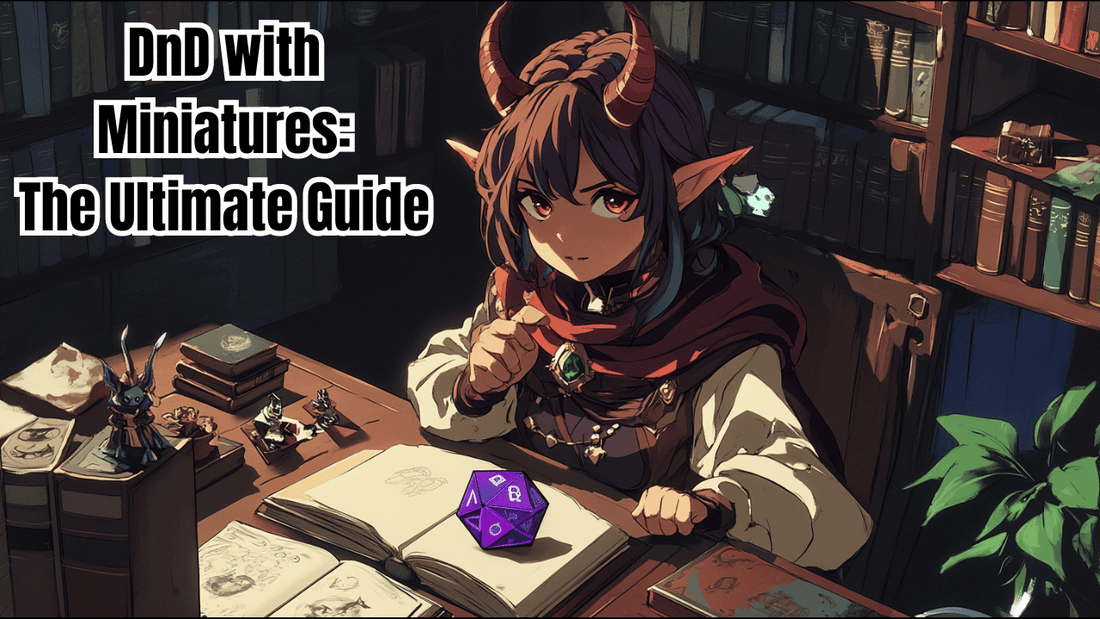
The Ultimate Guide to Playing Dungeons and Dragons with Miniatures
Dan KellyShare
Welcome, fellow adventurers, to the magical world of Dungeons and Dragons (D&D), where your wildest fantasies come to life and epic adventures await at every turn. Whether you're a seasoned dungeon master or a fresh-faced adventurer, adding Dungeons and Dragons miniatures to your gameplay can elevate your experience to new heights. In this comprehensive guide, we'll explore everything you need to know about D&D miniatures, from their history and benefits to tips for integrating them into your campaigns. So grab your dice, prepare your spell book, and let's embark on this grand adventure together!
The Origins of Dungeons and Dragons Miniatures
Before we dive into the nitty-gritty details of using miniatures in your D&D game, let's take a moment to appreciate their origins. The use of miniatures in tabletop gaming dates back to the early days of wargaming. H.G. Wells, often considered the father of modern tabletop gaming, introduced the concept in his 1913 book "Little Wars." This revolutionary idea of using small figurines to represent soldiers on a battlefield laid the groundwork for what would eventually become a staple in D&D gameplay.
Fast forward to the 1970s, when Gary Gygax and Dave Arneson created Dungeons and Dragons, the world's first role-playing game. Miniatures quickly found their place in the game, helping players visualise their characters and the world around them. Today, Dungeons and Dragons miniatures have evolved into highly detailed and collectible pieces that add a tactile dimension to your gaming sessions.
Why Use Dungeons and Dragons Miniatures?
Enhanced Immersion and Visualisation
One of the primary benefits of using D&D miniatures is the enhanced immersion they provide. Picture this: your party is exploring a dark, ominous dungeon. As the dungeon master describes the eerie ambiance and the flickering torchlight, you place a miniature of a menacing dragon on the table. Suddenly, the danger feels real, and the stakes are higher. Miniatures help bridge the gap between imagination and reality, making the game world more tangible and immersive.
Improved Tactical Gameplay
Dungeons and Dragons is a game of strategy and tactics. Miniatures excel in providing a visual representation of the battlefield, allowing players to plan their moves with precision. When you can see exactly where your character is in relation to enemies, obstacles, and allies, you can make more informed decisions. This added layer of tactical depth can turn a good game into a great one, where every move matters, and every choice has consequences.
Character Personalisation and Expression
Let's face it, part of the fun of playing D&D is creating and personalising your character. With D&D miniatures, you can take that customisation to the next level. Many companies offer a wide range of miniatures that can be customised to match your character's appearance, equipment, and even their personality. Painting your miniatures is another way to express your creativity and bring your character to life.
Collectibility and Community
Collecting Dungeons and Dragons miniatures is a hobby in itself. Many players take pride in their extensive collections, showcasing miniatures from various editions, special sets, and limited releases. Additionally, painting and displaying your miniatures can be a social activity, bringing together fellow enthusiasts to share tips, techniques, and stories. The sense of community that comes with collecting and painting D&D minis is an added bonus.
Getting Started with Dungeons and Dragons Miniatures
Choosing Your Miniatures
When it comes to selecting D&D miniatures, the options are vast and varied. Here are a few tips to help you get started:
-
Starter Sets: If you're new to the world of miniatures, consider starting with a pre-packaged starter set. These sets typically include a variety of figures, such as heroes, monsters, and NPCs, giving you a solid foundation for your collection.
-
Character-Specific Miniatures: Once you have a basic collection, you can start adding miniatures that represent specific characters in your campaign. Look for miniatures that closely match your character's race, class, and equipment.
-
Monsters and Enemies: No D&D campaign is complete without a host of fearsome foes. Invest in miniatures of common monsters and enemies to bring your battles to life. Dragons, goblins, and skeletons are always good choices.
-
Scenery and Terrain: To create a truly immersive experience, consider adding miniature scenery and terrain pieces. Trees, rocks, and buildings can help set the scene and make your game world feel more dynamic.
Painting Your Miniatures
Painting your D&D miniatures is a rewarding and creative endeavor. Here are some basic steps to get you started:
-
Prepare Your Miniatures: Before you start painting, make sure your miniatures are clean and free of any mold lines or flash. You can use a hobby knife to carefully remove any imperfections.
-
Prime Your Miniatures: Applying a primer helps the paint adhere better to the miniature's surface. Choose a primer colour that matches the overall tone of your character (e.g., white for bright colours, black for darker tones).
-
Basecoat: Start by applying a basecoat of the primary colour to your miniature. Use thin layers of paint to avoid obscuring the details.
-
Layering and Shading: Build up layers of color, gradually adding highlights and shadows to create depth and dimension. Techniques like dry brushing and washes can help enhance the details.
-
Detail Work: Once the main colours are in place, focus on the finer details, such as eyes, weapons, and accessories. Take your time to ensure precision.
-
Sealing: After the paint is dry, apply a clear sealant to protect your miniature and give it a finished look.
Integrating Miniatures into Your Campaign
Now that you have your miniatures ready, it's time to integrate them into your D&D campaign. Here are some tips for making the most of your D&D miniatures:
-
Map and Grid: Use a battle map or grid to represent the terrain and track the movement of characters and enemies. Many maps come with pre-printed grids, but you can also create your own.
-
Placement and Movement: Place the miniatures on the map to represent the starting positions of your characters and enemies. Use the grid to track movement, ensuring that each square represents a specific distance (e.g., 5 feet).
-
Combat Visualisation: During combat, move the miniatures according to the rules of the game. This visual representation helps players understand positioning, range, and line of sight.
-
Environmental Interaction: Encourage players to interact with the environment by using scenery and terrain pieces. Miniatures can climb obstacles, hide behind cover, or use terrain to their advantage.
-
Narrative Enhancement: Use miniatures to enhance the storytelling aspect of your campaign. Place miniatures to represent important NPCs, key locations, and dramatic moments.
Advanced Tips for Using Dungeons and Dragons Miniatures
Dynamic Posing and Customisation
One way to take your D&D miniatures to the next level is by customising their poses and accessories. Many miniatures come with interchangeable parts, allowing you to create unique and dynamic figures. Consider the following customisation ideas:
-
Alternate Weapons: Swap out weapons to match your character's current equipment. A wizard can switch between a staff and a wand, while a fighter can alternate between a sword and an axe.
-
Scenic Bases: Use scenic bases that can be customised with different terrain elements. This allows you to create a variety of environments for your miniatures to explore and help stage your model and help to tell their story.
-
Conversions: For the truly ambitious, try converting miniatures by combining parts from different figures. This can result in entirely new and unique characters. You can do this digitally and then 3d print the finished model, but you can also modify a physical miniature using a range of tools and some epoxy putty such as Kneadatite (aka Greenstuff).
Creating Epic Battle Scenes
One of the most exciting aspects of using D&D miniatures is staging epic battle scenes. Here are some tips for creating memorable encounters:
-
Set the Scene: Use terrain and scenery to create a visually stunning battlefield. Rocky cliffs, ancient ruins, and dense forests can add depth and realism to your encounters.
-
Narrative Elements: Incorporate narrative elements into your battle scenes. Place miniatures to represent key plot points, such as a captured ally or a powerful artifact.
-
Multi-Level Terrain: Add verticality to your battles by using multi-level terrain. Platforms, bridges, and ledges can create dynamic and strategic combat situations.
-
Lighting and Effects: Enhance the atmosphere with lighting and effects. Use LED lights to simulate torches and fires, and incorporate fog machines or dry ice for a misty, eerie ambiance.
Engaging Your Players
Using Dungeons and Dragons miniatures is not just about visual appeal—it's also about engaging your players. Here are some ways to keep your players invested in the game:
-
Encourage Roleplay: Encourage players to describe their actions and interactions with the miniatures. This adds depth to the characters and makes the game more immersive.
-
Use Props: Incorporate props, such as handwritten notes, maps, and tokens, to enhance the storytelling. These physical elements can make the game feel more tangible and real.
-
Interactive Elements: Introduce interactive elements, such as puzzles and traps, that players can physically manipulate. This adds a hands-on aspect to the game and keeps players engaged.
-
Reward Creativity: Reward players for creative and strategic use of miniatures. If a player comes up with a clever way to use the environment or their miniature's abilities, acknowledge their ingenuity with in-game rewards or bonuses.
Everyday Mishaps as Roleplay Opportunities
Playing Dungeons and Dragons is full of unexpected moments and hilarious mishaps. Here’s how you can turn these everyday occurrences into roleplaying gold:
The Great Goblin Fiasco
During a particularly tense battle with a group of goblins, one player's miniature took an unexpected tumble off the table. Rather than breaking the immersion, the group decided to roll with it. They declared that the character had been knocked off a cliff by a mischievous goblin. The player spent the rest of the session trying to climb back up, turning an accident into a memorable and fun side quest.
Critical Failures
There's nothing quite like a critical failure to add a bit of comedy to the game. One player, attempting a daring leap across a chasm, rolled a natural one and ended up dangling precariously from the edge. The group decided that the character had tripped over their own feet, leading to a series of unfortunate events that included losing a boot and nearly falling to their doom.
Unexpected Allies
In a twist of fate, the party's bard managed to charm a group of bandits using an impromptu song about cheese. The bandits, who turned out to be cheese enthusiasts, joined the party for a brief adventure, providing comic relief and a surprising amount of knowledge about dairy products.
Conclusion
Dungeons and Dragons miniatures add a whole new dimension to your tabletop adventures. From enhancing immersion and visualisation to improving tactical gameplay and character personalisation, these tiny figures pack a big punch. Whether you're just starting out or you're a seasoned collector, integrating D&D miniatures into your campaign can make your gaming sessions more engaging and memorable.
So why not take the plunge? Explore the vast world of Dungeons and Dragons miniatures, get creative with painting and customisation, and bring your game to life like never before. Remember, in the world of D&D, the only limit is your imagination—and maybe your paint budget. Happy adventuring, and may your rolls always be high!
Start by checking out our Heroes collection and see what catches your eye!
